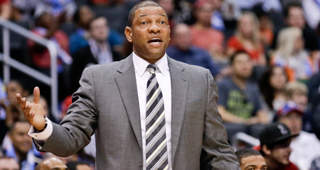Looming in the background of larger discussions about how Los Angeles Clippers’ ownership could (or should) view the goals of the franchise is a simple truth: it will be hard for the team to get much better while retaining the core of Blake Griffin, Chris Paul, DeAndre Jordan and JJ Redick.
Even though Griffin and Paul signed long before the big cap increases and Jordan’s contract will look great compared to what big men get this summer, their combined salaries create a logistical problem for the next few years.
For the 16-17 season, those four players (while each making less than their value on the open market) have locked-in salaries totaling ~$71.5 million. Adding Paul Pierce and more than $1 million in money paid to players no longer on their roster puts the Clippers close enough to the $89 million salary cap to make them a small factor in free agency even if they cut everyone else loose. A similar situation will be the case in 17-18 as well despite the fact that Paul, Griffin and Redick will be free agents with cap holds smaller than their expected starting salaries for that season.
Those limitations mean Doc Rivers and the Clippers' front office must do everything in their power to squeeze everything they can out of their other assets to get the best possible team. Strangely enough, Lance Stephenson plays a major part in that process. Stephenson’s contract includes a team option for next season worth about $9.4 million that whoever holds his rights at the end of the season must decide on before the league year turns over July 1. Beyond forcing an early decision, that also means that the Clippers cannot trade Stephenson in the span between the end of the season and July 1 without picking up that 16-17 option he will not be worth and a July sign-and-trade is likely off the table because so many teams have enough cap space to sign him outright. As such, the Clippers have a rare opportunity to make their own team better while also creating an asset that holds value to some other franchises.
While there are less bad contracts than any time in recent NBA history, some teams would be thrilled to clean up their books. The challenge for the Clippers is that most of these trade targets would not make them substantially better in the near-term or long-term because otherwise their teams would not want to trade that player for Stephenson. That said, something is better than nothing, especially when the Clippers are on the fringe of title contention. Potential targets include: Kevin Martin (who has a player option for next season), Rodney Stuckey, Alexis Ajinca, Kenneth Faried, Carl Landry and Corey Brewer. The Clippers do not have many sweeteners to get the better players on this list since they owe a future first to Toronto from the 2014 Jared Dudley trade and various second rounders over the next few seasons. That likely takes Faried and possibly Ajinca off the table but they represent the Clippers’ best-case scenario if those players’ current teams are optimistic about using that increased cap flexibility over the summer.
This same logic could hold for Jamal Crawford but his smaller contract and key role make trading him a more dangerous proposition for a team still gunning for a championship.
Kevin Martin may be the best example of the opportunity the Clippers need to take with Lance Stephenson’s contract. Minnesota’s young perimeter players have largely pushed Martin out of the rotation and his $7.4 million player option for next season is unlikely to net the Wolves an asset in a trade. As such, a Stephenson/Martin swap allows Minnesota to clean up their books basically no cost. The Clippers could even ask for Adreian Payne or a lesser draft pick as compensation for the service though that could be too step an asking price. Even if Martin opts out, the Clippers would be left in a somewhat better place than with Stephenson since they would hold Martin’s full Bird rights, allowing them to go over the cap to bring him back if desired.
The Clippers’ situation also has another wrinkle that is genuinely unique in NBA history. A rising cap and an owner willing to spend gives the team a nice avenue to retain their own players who become free agents if they hold their full Bird rights but that only applies to Crawford, Stephenson (if the team keeps him and declines his option) and one other player who just so happens to be the son of the team’s head coach and president of basketball operations. If Austin Rivers declines his $3.3 million player option, the Clippers would be allowed to spend any amount up to his maximum with very few other ways to spend money this summer. We will have to wait until July to see how that situation plays out but it will be worth watching.



